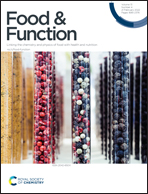Proanthocyanidins from Chinese bayberry leaves reduce obesity and associated metabolic disorders in high-fat diet-induced obese mice through a combination of AMPK activation and an alteration in gut microbiota†
Abstract
Regulating host energy metabolism and re-shaping gut microbiota are effective strategies against high-fat diet (HFD)-induced obesity and related metabolic disorders. A special type of proanthocyanidin extracted from Chinese bayberry leaves (BLPs) was studied for its effects and mechanisms in preventing HFD-induced obesity in mice. BLPs significantly reduced body weight, ameliorated inflammation and regulated gut dysbiosis in HFD-fed mice. BLPs activated AMP-activated protein kinase (AMPK) in the liver and white adipose tissue (WAT), which led to the downregulation of genes related to lipogenesis (ACC, FAS and SREBP-1c), and the upregulation of genes related to β-oxidation. Furthermore, BLPs improved HFD-induced gut dysbiosis by sharply decreasing the percentage of an endotoxin-producing bacteria – Desulfovibrionaceae, and enabling some distinct bacteria, such as Peptococcaceae, Clostridiaceae and Desulfovibrio. BLPs also reduced the circulated endotoxin and maintained the gut barrier's integrity. Further antibiotic treatment revealed that depleting the gut microbiota abrogated the anti-obesogenic effects of BLPs, yet did not affect AMPK activation. Collectively, these results suggest that BLPs reduce obesity and associated metabolic disorders in HFD-fed mice through a combination of AMPK activation and an alteration in gut microbiota.



 Please wait while we load your content...
Please wait while we load your content...